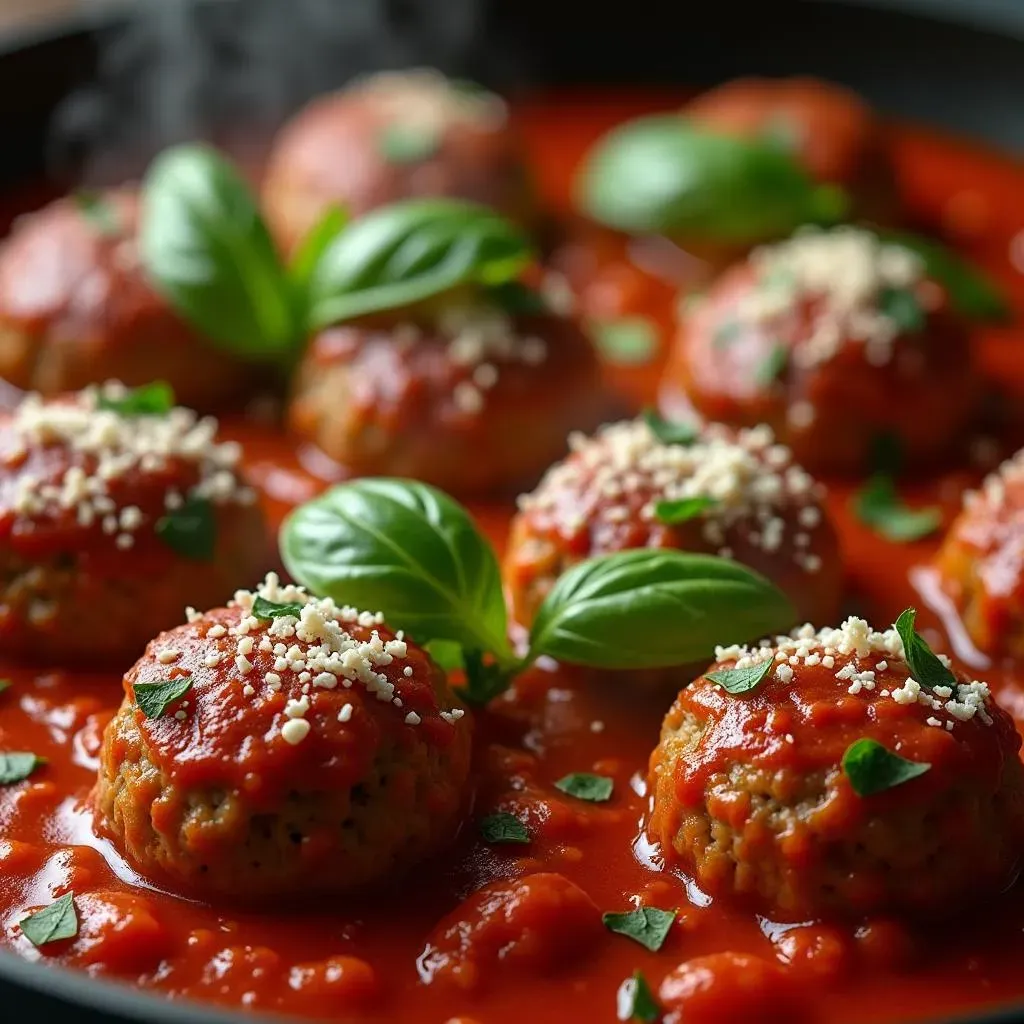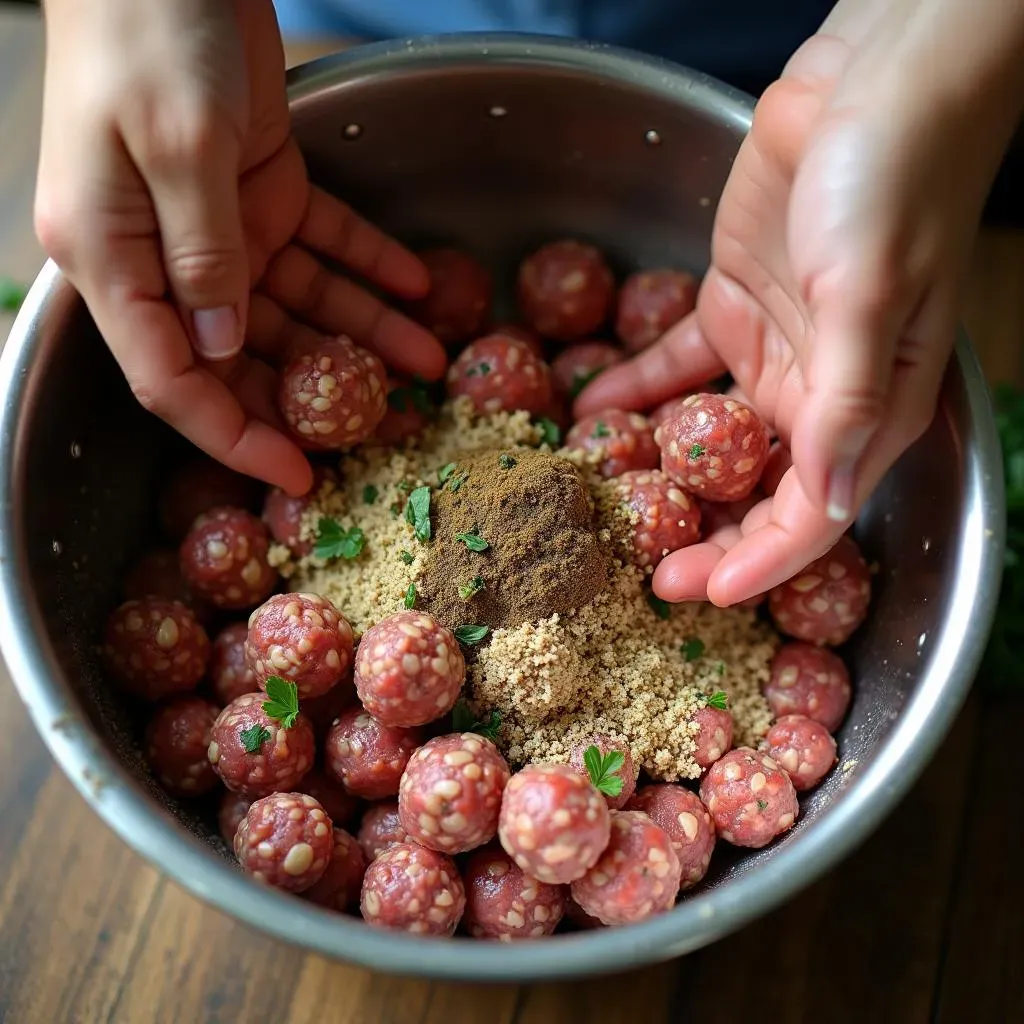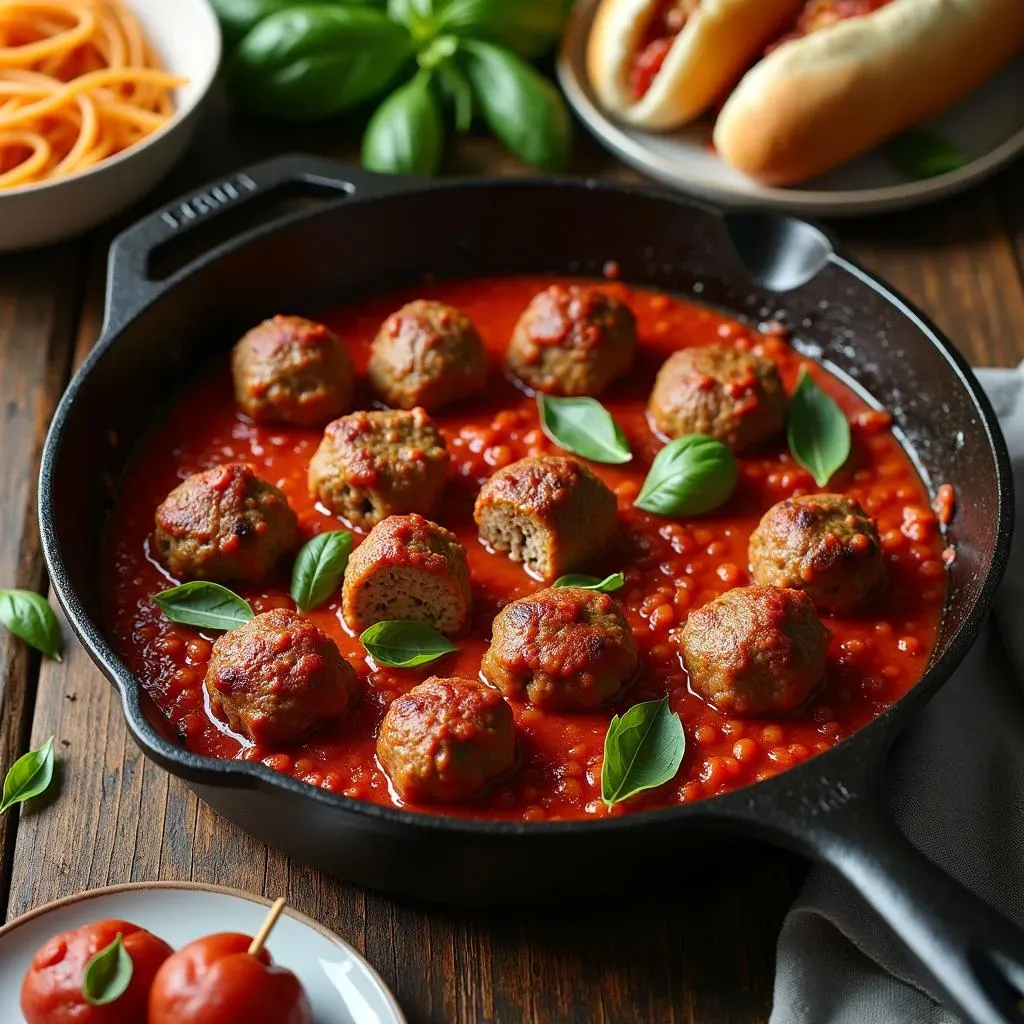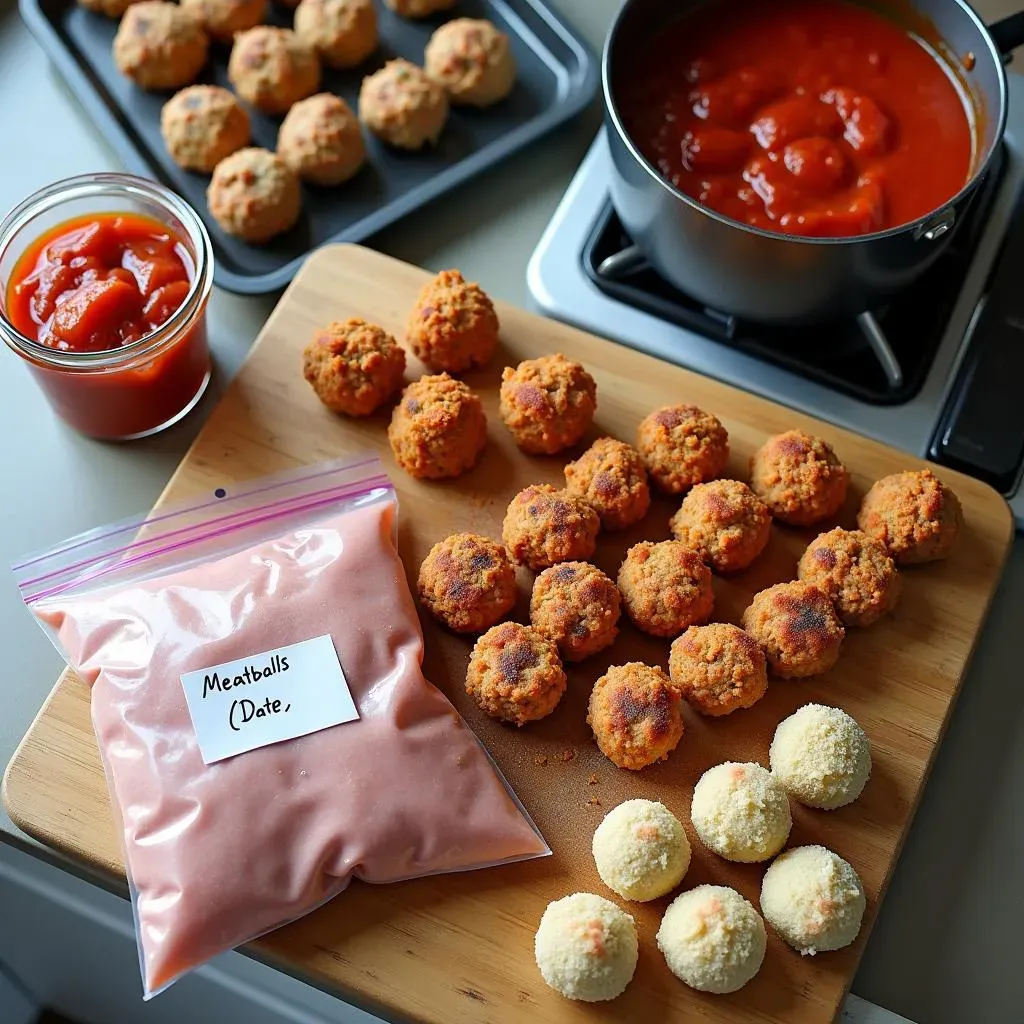Craving that classic comfort food that warms you from the inside out? Look no further than the humble meatball. But not just any meatball – we're talking about the best homemade meatball recipes, the kind that makes your Nonna proud. Forget bland, dry meatballs; we're diving into a world of tender, juicy, and flavor-packed perfection.
The Secret to the Best Homemade Meatball Recipes: Ingredients and Tips

The Secret to the Best Homemade Meatball Recipes: Ingredients and Tips
Alright, let's talk meatballs! The *secret* to truly amazing meatballs isn't some guarded family heirloom recipe (though those are great, too!). It's about understanding the ingredients and how they work together. Think of it like building a house – you need the right foundation to create something strong and delicious. We're going to break down each component, from the meat to the binders, and even the flavor boosters, so you can customize your meatballs to your exact liking.
First things first, let's talk meat. While beef is the traditional choice, don't be afraid to experiment! A blend of ground beef, pork, and veal is a classic combo for a reason – each brings something unique to the table. The beef provides that hearty, savory flavor, the pork adds richness and moisture, and the veal contributes a delicate tenderness. But what if you don't have veal on hand? No problem! You can substitute with more beef or pork, or even try ground chicken or turkey for a lighter option. The key is to use a blend of different meats to create a complex flavor profile.
And speaking of meat, fat content matters! Lean ground beef (90/10) might seem like a healthier choice, but it can result in dry, crumbly meatballs. Opt for ground beef with a higher fat content (80/20 or even 70/30) for a juicier, more flavorful result. The fat renders during cooking, basting the meatballs from the inside out and keeping them incredibly moist. Don't worry, you're not going to eat all that fat – much of it will render out into the sauce. But trust me, it makes a world of difference in the final product.
Now, let's move on to the binders. This is where things get interesting. Most recipes call for breadcrumbs, but the *real* secret to tender meatballs is using bread soaked in milk or water. This creates a panade, which is a mixture of bread and liquid that helps to bind the meat together and keep it incredibly moist. The bread absorbs the liquid and swells, creating a soft, pillowy texture that prevents the meatballs from becoming dense and tough. Trust me on this one – it's a game-changer!
Finally, let's talk flavor boosters. This is where you can really get creative and customize your meatballs to your liking. Garlic is a must-have, of course, but don't be afraid to experiment with other herbs and spices. Fresh parsley, oregano, basil, and rosemary are all great choices. You can also add grated Parmesan cheese for a salty, umami kick. And don't forget the salt and pepper! Seasoning is key to bringing out the natural flavors of the meat and other ingredients. Be generous with the salt, but be careful not to overdo it with the pepper. A pinch of red pepper flakes can also add a nice touch of heat.
Beyond the basics, consider adding a touch of sweetness with a little grated carrot or a splash of balsamic vinegar. A pinch of nutmeg can add a warm, subtle flavor that complements the other spices. And if you're feeling adventurous, try adding a little bit of chopped pancetta or prosciutto for a smoky, savory depth. The possibilities are endless! Just remember to taste as you go and adjust the seasonings to your liking. After all, the best meatball recipe is the one that you love the most.
Ingredient | Purpose | Tips |
|---|---|---|
Ground Beef (80/20) | Base flavor, richness | Don't go too lean, fat = flavor & moisture! |
Ground Pork | Adds moisture and tenderness | Can substitute with more beef if needed |
Soaked Bread (Panade) | Binds, adds moisture, tenderizes | Use milk or water, squeeze out excess liquid |
Garlic, Herbs, Spices | Flavor boosters | Fresh is best, experiment with your favorites! |
StepbyStep Guide: Crafting Your Own Best Homemade Meatballs

StepbyStep Guide: Crafting Your Own Best Homemade Meatballs
Getting Your Hands Dirty: Mixing Like a Pro
now for the fun part! Once you've gathered your ingredients, it's time to get your hands dirty and mix everything together. But before you start tossing everything into a bowl, there's a little trick to keep in mind: don't overmix! Overmixing can lead to tough, dense meatballs, and nobody wants that. The goal is to gently combine the ingredients until they're just evenly distributed. I usually use my hands for this – it's the best way to feel the texture and ensure everything is properly mixed without overdoing it.
Start by placing your ground meat(s) in a large bowl. Then, add your soaked bread (make sure to squeeze out any excess liquid!), minced garlic, chopped herbs, grated Parmesan cheese, eggs, salt, pepper, and any other spices you're using. Gently mix everything together with your hands, using a light, folding motion. Avoid squeezing or compacting the mixture, as this will make the meatballs tough. Just keep mixing until everything is evenly combined, and you can no longer see any streaks of individual ingredients. That's when you know you're done!
Step | Description | Tip |
|---|---|---|
1. Combine Ingredients | Add all ingredients to a large bowl. | Make sure bread is well-squeezed! |
2. Gently Mix | Use your hands for the best feel. | Avoid overmixing to keep meatballs tender. |
3. Even Distribution | Mix until ingredients are just combined. | No streaks of individual ingredients should be visible. |
Shape Up: Rolling the Perfect Meatball
Alright, the mix is ready, so the next step is to shape the meatballs. Now, size matters here, depending on what you're planning to do with them. For spaghetti and meatballs, I usually go for about 1.5-inch meatballs – roughly the size of a golf ball. If you're making sliders or using them in soup, you might want to go a bit smaller. The key is to keep them uniform in size so they cook evenly. Eyeballing it works, but if you're a perfectionist, you can use a cookie scoop to ensure each meatball is exactly the same size.
To roll the meatballs, lightly wet your hands with cold water. This will prevent the meat from sticking to your hands and make it easier to form smooth, round meatballs. Take a portion of the meat mixture and gently roll it between your palms until it forms a ball. Avoid squeezing or compacting the meat too much, as this can make the meatballs tough. Place the formed meatballs on a baking sheet lined with parchment paper. This will prevent them from sticking and make cleanup a breeze. Repeat until all the meat mixture has been used.
Cooking and Serving: Perfecting Your Best Homemade Meatball Recipes

Cooking and Serving: Perfecting Your Best Homemade Meatball Recipes
Choose Your Own Adventure: Cooking Methods
Alright, you've got these beautiful, perfectly shaped meatballs ready to go. Now comes the big question: how are you going to cook them? You've basically got two main options here: baking or simmering in sauce. Both have their pros and cons, and honestly, it comes down to personal preference and what you're going for. I often bake them because it's hands-off and they get a nice, even browning all over. But simmering them in sauce? That infuses them with so much flavor, it's hard to resist. Let's break down both methods.
Baking is super simple. Preheat your oven to 425°F (220°C), place the meatballs on a baking sheet lined with parchment paper, and bake for about 20-25 minutes, or until they're cooked through and nicely browned. The parchment paper prevents sticking and makes cleanup a breeze. Baking is great because it doesn't require a lot of attention, and the meatballs get a nice crust on the outside. Plus, you can bake a whole batch at once, which is perfect for meal prepping or feeding a crowd.
Cooking Method | Pros | Cons |
|---|---|---|
Baking (425°F/220°C) | Hands-off, even browning, easy cleanup | Can be slightly drier than simmering |
Simmering in Sauce | Infuses flavor, keeps meatballs moist | Requires more attention, can be messy |
Sauce Boss: Simmering for Flavor
Now, simmering in sauce is where the magic really happens. This method not only cooks the meatballs but also infuses them with tons of flavor from the sauce. To simmer, simply add the meatballs to your favorite tomato sauce (homemade or store-bought, no judgment!), bring to a simmer, and cook for at least 30 minutes, or up to a few hours. The longer they simmer, the more flavorful they'll become. Just be sure to stir occasionally to prevent sticking and ensure they cook evenly.
One thing I like to do is brown the meatballs in a skillet before simmering them in sauce. This adds an extra layer of flavor and helps to seal in the juices. To do this, heat a little olive oil in a skillet over medium-high heat, and brown the meatballs on all sides before adding them to the sauce. This step is optional, but it's definitely worth the effort if you want to take your meatballs to the next level. Regardless of which method you choose, make sure the meatballs are cooked through before serving. The internal temperature should reach 165°F (74°C). You can use a meat thermometer to check for doneness.
Serving Suggestions: Beyond Spaghetti
the meatballs are cooked, the sauce is simmering, now what? The most obvious answer is, of course, spaghetti and meatballs! But don't limit yourself. Meatballs are incredibly versatile and can be used in a variety of dishes. Think meatball subs, meatball sliders, meatball soup, or even meatball pizza. You can also serve them as an appetizer with toothpicks and a dipping sauce. The possibilities are endless!
When serving, don't forget the garnishes! A sprinkle of fresh parsley, a dollop of ricotta cheese, or a drizzle of olive oil can add a touch of elegance to your dish. And of course, a generous grating of Parmesan cheese is always a welcome addition. Whether you're serving them as a main course or an appetizer, meatballs are always a crowd-pleaser. So, go ahead and get creative, and enjoy the deliciousness that is homemade meatballs!
MakeAhead, Storage, and Reheating: Enjoying Your Best Homemade Meatball Recipes Later

MakeAhead, Storage, and Reheating: Enjoying Your Best Homemade Meatball Recipes Later
Prep Like a Pro: Making Meatballs in Advance
Life's busy, right? So, the beauty of these best homemade meatball recipes is how incredibly make-ahead friendly they are. Seriously, you can knock out a huge batch on the weekend and have deliciousness ready to go whenever you need it during the week. The easiest way to do this is to prepare the meatball mixture as directed, roll them into balls, and then, here's the key, place them on a baking sheet lined with parchment paper. At this point, you have a choice: you can either bake them as usual and then store them, or you can freeze them raw.
If you're going to bake them first, let them cool completely before storing them in an airtight container in the refrigerator. They'll keep for up to 3-4 days this way. Freezing raw meatballs is also super simple. Just place the baking sheet with the raw meatballs in the freezer for about an hour or two, or until they're frozen solid. This prevents them from sticking together when you store them. Once they're frozen, transfer them to a freezer bag or airtight container. They'll keep in the freezer for up to 2-3 months. Don't forget to label the bag with the date, so you know when you made them!
Make-Ahead Option | Instructions | Storage |
|---|---|---|
Baked Meatballs | Bake as directed, cool completely. | Airtight container in the fridge (3-4 days). |
Raw Meatballs | Freeze on a baking sheet, then transfer to a freezer bag. | Freezer bag in the freezer (2-3 months). |
Reviving Your Meatballs: Reheating Like a Champ
so you've got your meatballs stored and ready to go. Now, how do you reheat them without drying them out or losing that amazing flavor? Well, it depends on whether they're baked or raw, and what you're planning to serve them with. If you're reheating baked meatballs, the easiest way is to simply toss them into a pot of simmering tomato sauce. The sauce will help to rehydrate them and keep them nice and moist. Heat them through gently until they're warmed all the way through. You can also reheat them in the oven. Place them on a baking sheet and bake at 350°F (175°C) for about 10-15 minutes, or until they're heated through. Just be careful not to overcook them, or they'll dry out.
If you're reheating raw meatballs, you don't need to thaw them first. Just add them directly to a pot of simmering tomato sauce and cook them until they're cooked through, about 30-40 minutes. Again, make sure the internal temperature reaches 165°F (74°C). You can also bake them from frozen. Place them on a baking sheet and bake at 400°F (200°C) for about 25-30 minutes, or until they're cooked through. No matter which method you choose, make sure to add a little extra sauce or water to the pot or baking sheet to prevent them from drying out. And there you have it! Perfectly reheated meatballs, ready to be enjoyed in all their delicious glory.
Sauce Savvy: Reheating in Sauce for Maximum Flavor
Let's dive a little deeper into the art of reheating meatballs in sauce because, honestly, it's the *best* way to do it. Not only does it warm them up, but it also infuses them with even more flavor. Whether you're using a homemade marinara or your favorite jarred sauce, the process is pretty straightforward. If your sauce is already heated, gently drop the meatballs in. If the sauce is cold, add the meatballs and then bring it up to a simmer. The key is to let them simmer gently, not boil, for at least 15-20 minutes. This allows the meatballs to absorb the sauce and become super flavorful.
One trick I've learned is to add a splash of red wine to the sauce while reheating. It adds a depth of flavor that's just incredible. You can also add a bay leaf or a sprig of fresh rosemary for extra aroma. And if you're feeling fancy, a dollop of ricotta cheese on top of each meatball before serving is always a winner. The possibilities are endless! So, go ahead and experiment, and find your own perfect way to reheat meatballs in sauce. Your taste buds will thank you for it.
Conclusion: Mastering the Art of the Best Homemade Meatball Recipes
So, there you have it – your guide to creating the best homemade meatball recipes imaginable. From selecting the right ingredients and mastering the techniques to storing and reheating like a pro, you're now equipped to impress family and friends with these flavorful spheres of deliciousness. Don't be afraid to experiment with different herbs, spices, and sauces to truly make them your own. Now, go forth and create meatball magic in your kitchen!